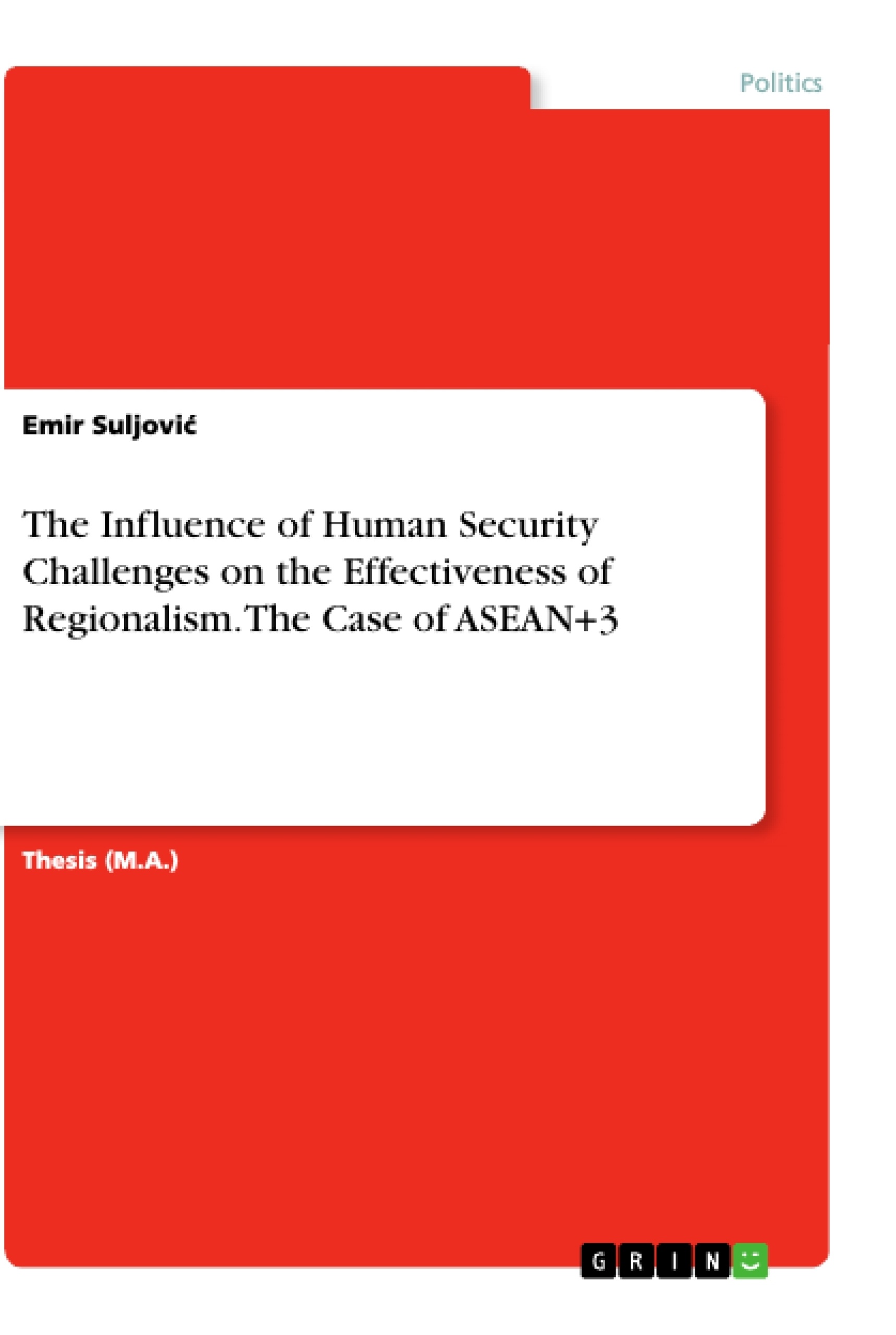The aim of this research is to address the gap of the non-state-centric approach of human security to the notion of regionalism that has been dominated by the state-centric definition of security so far.
Thereby the object of reference is not the state but the individual itself. This thesis assists in broadening the knowledge of regionalism but also puts high emphasis on the concept of human security and the affiliated challenges such as ethnic cleansing, human rights violation, genocide, migration influx and territorial disputes in the region of ASEAN+3. Although the RIO has been acknowledged and recognized as one of the successful examples of regionalism, the controversy about its consensus, its decision-making mechanism, and its non-interference mentality undermines its economic success by exposing millions of individuals to a variety of threats. Nevertheless, this would not have been considered ASEAN’s issue if the RIO did not commit itself for maintaining peace and regional stability in its charter, official statements, and treaty. Furthermore, this thesis does not marginalize the RIO’s economic success nor its economic effectiveness, but it rather asks how effective regionalism is with regard to traditional and non-traditional threats under the same umbrella term of human security challenges.
ASEAN+3 cannot uphold its principles and values expressed in its official documents. At the same time, the organization cannot replicate the same effectiveness and success that it has in its economic policies in the area of human security. As the pillar of all types of security, human security is under-implemented, under-promoted and under-represented in the case of East and Southeast Asia that adumbrates its economic achievements.
Inhaltsverzeichnis (Table of Contents)
- What is Human Security?
- UN about Human Security
- Research about Human Security
- Effectiveness or Performance of Regional International Organisations?
- Human security (challenges) and ASEAN+3
- Human security and ASEAN+3
- Human security challenges and ASEAN+3
- Methodology
- Case Studies Introduction
- Case Study 1: Myanmar's Human Security
- Case Study 2: Korean Human Security
- Case Study 3: South China Sea Dispute
- Analysis
- Case Study 1: Rohingya Crises – Analysis
- Case Study 2: Korean Peninsula Crises - Analysis
- Case Study 3: South China Sea Dispute - Analysis
- Effectiveness of ASEAN+3 in Case Study 1
- Effectiveness of ASEAN+3 in Case Study 2
- Effectiveness of ASEAN+3 in Case Study 3
Zielsetzung und Themenschwerpunkte (Objectives and Key Themes)
This research aims to bridge the gap between the individual-centric approach of human security and the state-centric definition of security that has dominated the discourse of regionalism. The focus shifts from the state to the individual, expanding the understanding of regionalism and highlighting the concept of human security and its associated challenges such as ethnic cleansing, human rights violations, genocide, migration influx, and territorial disputes within the ASEAN+3 region.
- Human security and its challenges in the context of regionalism.
- The effectiveness of regional international organisations (RIOs) in addressing human security threats.
- The role of ASEAN+3 in promoting human security and responding to challenges in East and Southeast Asia.
- The limitations of ASEAN+3 in effectively addressing human security challenges despite its economic success.
- The need to prioritize human security in regional cooperation and integration.
Zusammenfassung der Kapitel (Chapter Summaries)
- What is Human Security? This chapter introduces the concept of human security, exploring its definition and evolution. It discusses the UN's perspective on human security and examines existing research in the field.
- Effectiveness or Performance of Regional International Organisations? This chapter delves into the concept of effectiveness within regional international organizations, analyzing their performance and challenges in addressing human security threats.
- Human security (challenges) and ASEAN+3 This chapter explores the intersection of human security and ASEAN+3. It examines the organization's commitment to human security and analyzes the various challenges the region faces, including ethnic cleansing, human rights violations, and territorial disputes.
- Methodology This chapter outlines the research methodology used to analyze the effectiveness of ASEAN+3 in addressing human security challenges.
- Case Studies Introduction This chapter provides an introduction to the three case studies that form the core of the analysis: Myanmar's Human Security, Korean Human Security, and the South China Sea Dispute.
- Case Study 1: Myanmar's Human Security This chapter examines the human security situation in Myanmar, focusing on the Rohingya crisis and its impact on the country's human security landscape.
- Case Study 2: Korean Human Security This chapter analyzes the human security situation on the Korean Peninsula, exploring the challenges and implications of the ongoing conflict.
- Case Study 3: South China Sea Dispute This chapter examines the human security implications of the territorial disputes in the South China Sea, focusing on the potential for conflict and instability.
- Analysis This chapter presents an in-depth analysis of the three case studies, assessing the effectiveness of ASEAN+3 in addressing the specific human security challenges encountered.
Schlüsselwörter (Keywords)
The research focuses on the concepts of human security, human security challenges, regionalism, regional integration, and the effectiveness of regionalism within the context of ASEAN+3. Key terms include human security, human security challenges, regionalism, regional integration, effectiveness of regionalism, ASEAN, and ASEAN+3. These terms highlight the central themes of the research, encompassing the intersection of human security, regionalism, and the organization's role in addressing complex challenges in East and Southeast Asia.
- Quote paper
- Emir Suljović (Author), 2019, The Influence of Human Security Challenges on the Effectiveness of Regionalism. The Case of ASEAN+3, Munich, GRIN Verlag, https://www.grin.com/document/903526



